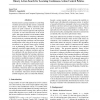34 search results - page 6 / 7 » Using Temporal Neighborhoods to Adapt Function Approximators... |
NIPS
1996
13 years 6 months ago
1996
Dynamic Programming, Q-learning and other discrete Markov Decision Process solvers can be applied to continuous d-dimensional state-spaces by quantizing the state space into an arr...
NIPS
1994
13 years 6 months ago
1994
It is widely accepted that the use of more compact representations than lookup tables is crucial to scaling reinforcement learning (RL) algorithms to real-world problems. Unfortun...
ATAL
2008
Springer
13 years 6 months ago
2008
Springer
In reinforcement learning, least-squares temporal difference methods (e.g., LSTD and LSPI) are effective, data-efficient techniques for policy evaluation and control with linear v...
ICML
2009
IEEE
14 years 5 months ago
2009
IEEE
Reinforcement Learning methods for controlling stochastic processes typically assume a small and discrete action space. While continuous action spaces are quite common in real-wor...
ECML
2006
Springer
13 years 8 months ago
2006
Springer
We target the problem of closed-loop learning of control policies that map visual percepts to continuous actions. Our algorithm, called Reinforcement Learning of Joint Classes (RLJ...

